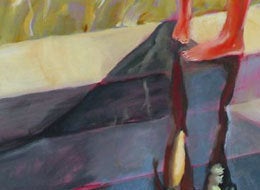
The arts have fallen victim to budget cuts in Kansas. Governor Sam Brownback recently signed legislation eliminating all state funding -- about $689,000 -- for arts programs, "leaving the Kansas Arts Commission without a budget, staff or offices." Nearly 200 local arts organizations and artists will lose critical support for local arts programs, operational funding and professional development. "In difficult fiscal times such as these, the state must prioritize how to spend its limited resources and focus its attention on providing core services," Brownback told legislators.
Brownback's preference is to replace the Arts Commission with a private, nonprofit foundation. Proposals to cut state arts councils have now been introduced in New Hampshire, Texas, and Washington. In the words of Robert Lynch, CEO of Washington-based lobbyist group, Americans for the Arts, "Kansas has now become a huge outlier. It's the only such decision made this year or in the past 50 years." Strong support for eliminating the Kansas Arts Commission came from the local branch of Americans for Prosperity (AFP), an anti-tax group founded by billionaire oilman David Koch, whose Koch Industries is based in Wichita.
"(No one) should be compelled to have part of their tax bill fund the tastes of those on an arts commission," wrote Kansas AFP director Derrick Sontag. "Art is in the eye of the beholder. Some may enjoy Picasso or listening to Beethoven. Others may prefer a Dogs Playing Poker painting."
Putting aside the fact that Mr. Sontag confuses kitsch with art (ironically, his namesake, Susan Sontag, parsed this difference beautifully in her essay, Notes on "Camp", let us look at the many premises of this particular argument. The implication of the Brownback decision is that the arts are a frivolous use of taxpayer dollars during a time of austerity and that government funding is entirely interchangeable with private donations. Additionally, there's the question of legitimation -- what's good and what's not -- which problematizes the incorporation of public funding. Let's address these step by step.
Why publicly support the arts when the debt's hitting its head against a $14 trillion ceiling and unemployment's at 9 percent? Well, for one thing, America's nonprofit arts and culture industry generates $166.2 billion in economic activity every year, according to a 2007 study by Americans For the Arts. This includes $63.1 billion in spending by organizations (that's twice as much as aerospace) and an additional $103.1 billion in event-related spending by audiences. The national impact of this activity is significant, supporting 5.7 million jobs and generating $29.6 billion in government revenue. Overall, the for-profit and non-profit culture industry generate nearly $30 billion in revenue to local, state and federal governments every year. By comparison, the three levels of government collectively spend less than $4 billion annually to support arts and culture -- a spectacular 7:1 return on investment; try getting that in mutual funds.
Want to get America working? The nonprofit arts and culture organizations support more jobs than there are accountants, auditors, public safety officers, even lawyers and just slightly fewer jobs than the elementary school teacher sector. Simply put, artists are workers -- real jobs that generate real value to our society.
Then there's the whole notion of urban renewal. Arts and culture create a hub around which retail, businesses and mixed-income housing congregate, often occupying buildings and lots that had been vacant and underused. The nation's creative economies host 2 million artists, 3.6 million cultural workers and 4.9 million cultural industry jobs. Creative destinations foster economic development, keep residents spending locally (rather than going to N.Y. to see a show) create jobs in construction, attract and retain non arts-related businesses and skills, while preserving the integrity of local culture. Not to mention that the arts are a tourist industry honeypot -- research repeatedly shows that cultural travelers stay longer and spend more.
OK, some might say, but why does the state have to fund it? The answer is because historically, state funding is the basis for granting federal awards, and the return on investment beats anything you could make playing blue-chip stocks. Like a Good Housekeeping seal, a National Endowment for the Arts endorsement has a powerful multiplying effect. Every dollar that the NEA gives typically generates seven to eight times more money in terms of matching grants, further donations, and earned revenue from the private sector. That's typically $700 million on a $100 million investment.
I can think of few uses of taxpayer dollars that can boast those kinds of numbers. And consider what's come out of it: early NEA support helped create major ongoing arts organizations as diverse as the American Film Institute, the Spoleto Festival USA, and the PBS series, Great Performances. Chicago's Steppenwolf Theater, which brought worldwide attention (and dollars) to new voices like David Mamet and Tracy Letts, and Jazz at Lincoln Center, (the world's largest nonprofit jazz organization) both grew out of NEA seed money. State arts agencies tend to support smaller and more local organizations, and younger, less established artists, as well as community groups, (which the NEA typically does not). Take the city of San Jose, which put together a technology/arts Biennial with crucial early public funding. The Biennial now draws 55,000 people and generates millions in local sales while creating jobs and nurturing art/technology projects that will grow future cultural industry businesses. It has since grown to the point that San Jose's public funding has been replaced by corporate sponsorships and philanthropy.
Finally, one must answer whether art serves the commonwealth. Our earliest forbears, for all the privations of their hunter/gatherer existence, clearly did not see it as frivolous to represent their experiences on the caves of Altamira or Chauvet (the subject of the recent Werner Herzog film, Cave of Forgotten Dreams). In reading some of the screeds against the NEA, it seems clear that our nation's politicians largely seem to conflate art with entertainment. The latter is the aesthetics and commerce of distraction; but the former is made of more serious stuff -- to place human experience into a symbolic register where it can be observed and contemplated and create new imaginaries. It's the analogue to thinking about things.
Politicians of previous eras understood this. For example, Franklin Delano Roosevelt's New Deal cultural programs marked the U.S. government's first big, direct investment in cultural development. At a time of widespread collapse, they emphasized the interrelatedness of culture with all aspects of life, not the separateness of a rarefied art world. Consider the words of Holger Cahill, director of the Federal Art Project in 1939.
"...the Project has discovered that such a simple matter as finding employment for the artist in his [sic] hometown has been of the greatest importance. It has, for one thing, helped to stem the cultural erosion, which in the past two decades has drawn most of America's art talent to a few large cities. It has brought the artist closer to the interests of a public which needs him, and which is now learning to understand him. And it has made the artist more responsive to the inspiration of the country, and through this the artist is bringing every aspect of American life into the currency of art."
- employed 5,300 visual artists (creating more than 2,500 murals, 108,000 paintings and some 18,000 pieces of sculpture), along with hundreds of teachers in settlements and community centers, where they taught 50,000 children and adults weekly;
- the Federal Music Project employed 16,000 musicians at its peak, presented 5,000 performances before some 3 million people each week, and provided classes in rural and urban areas to 132,000 children and adults in 27 states each week;
- the Federal Theater Project employed 12,700 at its peak in 31 states, and staged more than 1,000 performances each month before nearly 1 million people (78 percent of which attended free, many seeing live theater for the first time).
I have set out to defend art as an economic enterprise, but its purpose will always transcend this. It is about things that can't be reduced to the objective field and the territory of economics. It is about historical memory and creating an interpretive frame for the future. Consider the Harlem Renaissance, which forever altered the notion of African American subjectivity. Writers like Wright, Ellison and Hurston, and thinkers like Locke, Du Bois and Garvey created notions of spiritual recovery, cosmopolitanism and political agency that led us to President Obama in the White House. These ideas were allowed to flourish just 50 years after the end of slavery, despite decades of often inimical social policy. The arts did this. And the arts will endure because they are at the core of the human impulse. It's that simple. Art is undeniable.
It is time that we (and our politicians) embrace that.
Special thanks to the researcher and co-author of this article, Heather M. Carper. Heather grew up in Kansas, where the benefits of public and private arts education laid the foundation for her work, which has been featured in the Chicago Tribune, JHB Live! (Johannesburg) and has been translated into 7 languages. She now lives and works in Chicago.
